Sushi
About sushi

Sushi is one of most famous Japanese foods.
It is the food made of vinegared rice and fish or other ingredients.
Originally, Japanese people had pickled fish to preserve from spoiling.
It was a fermented food.
But in the 17th century, vinegar came to be used to ferment.
Since the 19th century, sushi was made by laying slices of raw fish on rice and rolling it by hand, in Edo (current Tokyo).
Because, Edo citizen disliked being slow and weren't able to wait until fish pickle is completed.
On the other hand, a lot of fresh fish had always been caught in Tokyo Bay in front of the city of Edo.
As a result, to eat whenever they want, they created a snack food "sushi" using fresh raw fish and the rice with the taste of fermentation by vinegar.
It is said that the word "sushi" is derived from an archaic Japanese adjective meaning "sour".
And, the words "in front of the city of Edo" is "Edomae" in Japanese.
So the sushi born in Edo has been called "Edomae-zushi".
(The word "sushi" sometimes changes to "zushi" when other word is connected.)
Probably, sushi you know is "Edomae-zushi".
Types of Edomae-zushi
The followings are the types of Edomae-zushi, and most sushi restaurants serve the types of sushi.
Nigiri-zushi

Nigiri-zushi is the most typical form of sushi.
"Nigiri" means "gripping".
The sushi chef presses half handful vinegared rice between the palm of his hands, and covers it with an ingredient.
At that time, a bit of wasabi (grated Japanese horseradish) is added as a spice.
If the ingredient is hard to hold the rice, he binds them with a thin band of nori.
Nigiri-zushi is often served in pairs when we ordered one favorite ingredient in sushi restaurant.
The style of service is a custom from ancient times.
The ingredients of nigiri-zushi are basically fresh raw fish, and they are same as sashimi.
Japanese people's favorite fish for sushi is maguro (tuna).
The raw flesh is dark red.
The main part is called "Akami" (Red flesh) in Japanese.

Chunk of tuna in fish market

Sushi of Akami
The fattest part in a tuna is called "toro" and the color is pinkish red.
It is the envy of all sushi-eater.
Especially, the best part is called "Oo-toro" (Great toro), and the other toro is called "Chu-toro" (Common toro).
Of course, toro is more expensive than Akami.
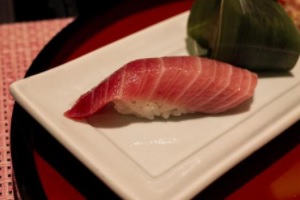
Sushi of Chu-toro

Sushi of Oo-toro
Various fish are used as the ingredient of Nigiri-zushi.
Each fish has a name, and you order the favorite sushi by the name when you eat in an authentic sushi restaurant.
Basically, raw fish are main.
But, prawn and octopus are mainly boiled.
Anago (Whitespotted conger) and eel are cooked as kabayaki (broiling with the sauce of shoyu and mirin).
In addition, there is an ingredient of omelet and it is called "Gyoku".
It is made by frying beaten eggs mixed with Japanese dashi broth soup.
The following ingredients are popular for Japanese people.

Salmon, Ebi (Boiled shrimp)

Tai (Sea bream), Hamachi (Yellow tail)

Hotate (Scallop), Ika (Squid)
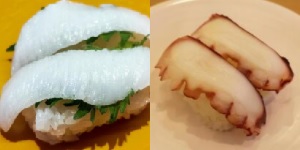
Engawa (Edge part of fish), Tako (Boiled octopus)

Amaebi (Raw pink shrimp), Aji (Horse mackerel)

Anago (Whitespotted conger), Gyoku
Gunkan-maki

Gunkan-maki is made by making a lump of handful vinegared rice, wrapping with a strip of nori, and filling in any ingredient as the topping.
The toppings are mainly Ikura (salmon roe), Uni (sea urchin), or Negitoro (minced tuna and chopped green onion), which are pulpy or loose ingredients.
The sushi of this type was invented by a sushi chef in Tokyo in 1941.
Therefore, because it is an exceptional type of sushi, traditional sushi bars make Gunkan-maki using only a few ingredients.
In Kaiten-zushi (Conveyor belt sushi) restaurants, various toppings such as Natto, Kanimiso (Innares of crab), Corn, etc. are added on the menu.
By the way, "Gunkan" means "warship".
This is named in that form.
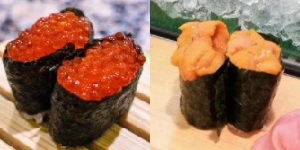
Ikura (Salmon roe), Uni (sea urchin)

Negitoro, Tobiko (Flying fish roe)
Maki-zushi
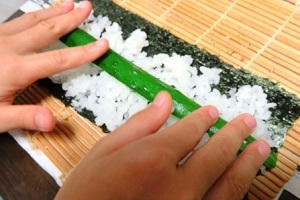
Maki-zushi means Sushi roll.
A maki-zushi is made by putting a sheet of nori on a bamboo mat, spreading vinegared rice and ingredients on it.
And, it is rolled with the help of a bamboo mat.
Usually it is served after cutting into several pieces.
There are some typical maki-zushi.
Kanpyo-maki is filled with Kanpyo (gourd strip) boiled with sweetened soy sauce.
Tekka-maki is filled with raw tuna.
Kappa-maki is filled with cucumber.
The diameter is within 3 cm, and these sushi rolls are collectively called Hoso-maki (Thin roll).
And, Futo-maki (Thick roll) is also popular sushi roll.
It is 4 to 5 cm in diameter and is often made with several fillings such as kanpyo, cucumber, omelet, etc.

Kanpyo-maki

Tekka-maki

Kappa-maki

Futo-maki
"California Roll" was invented by a Japanese sushi chef in Los Angels in 1963.
This isn't a traditional sushi of Japan.
Contrary to traditional maki-zushi, the outside of California Roll is rice, and nori is inside the roll.
Raw fish and wasabi aren't used, but avocado, cucumber, boiled crab meat etc. are used with mayonnaise, generally.
The reason was that raw fish and nori were not accepted to the customers in US.
It is popular in US, but few sushi restaurants in Japan serve the roll.
Some Kaiten-zushi (Conveyor belt sushi) restaurants serve it as a unique sushi menu.
Probably, most Japanese people think that California Roll is a unique rice food different from traditional sushi.
In fact, you will not find California Roll in any sushi restaurants, shops, convenient stores in Japan.
Types of sushi for takeout or making at home
Sushi roll is sometimes made at home.
But, it is difficult for common people to make Nigiri-zushi and Gunkan-maki, because much skill are needed to make them well.
On the other hand, there are a few types of sushi which sushi chef seldom make.
Oshi-zushi
Oshi-zushi means pressed sushi.
It is a block-shaped sushi formed using a wooden mold.
The cook puts the toppings of the sushi on the bottom of the wooden mold.
Vinegared rice is covered on them.
And the cook presses the lid of the mold down to create a compact sushi block.
The completed block is removed from the mold, and it is cut into bite-sized pieces.
Oshi-zushi has developed in western Japan rather than Tokyo.
Historically, this method is older than Nigiri-zushi.
When you travel around western Japan, you can find various oshi-zushi.
Most of them are sold at sushi shop etc. for takeout.
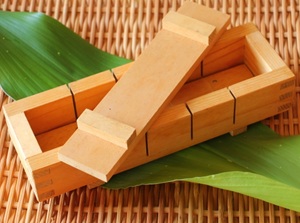
Wooden mold for Oshi-zushi

Set of Oshi-zushi
Local and typical oshi-zushi are the following.
Oshi-zushi of Saba (Mackerel) spreads widely in western Japan.
Battera in Osaka is popular as oshi-zushi of Saba.
Saba is marinated in vinegar and thin-sliced konbu (a seaweed) sheet is coated on the fish.
It is pressed for the sushi.
And, Masu (Trout), Anago (Whitespotted conger), Aji (Horse mackerel), etc. are used in each local area.
For portable lunch, there are a few oshi-zushi wrapped with leaves having bactericidal activity.

Battera

Oshi-zushi of Trout

Oshi-zushi of Anago
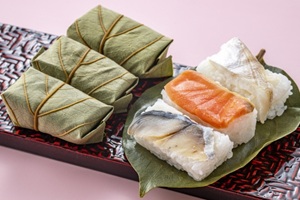
Oshi-zushi wrapped with persimmon leaves
Inari-zushi
Inari-zushi is a pouch of abura-age filled with vinegared rice.
Abura-age is a processed food that thin-sliced tofu is fried in deep-oil.
As the abura-age is boiled in the soup of shoyu and sugar in advance, it becomes salty-sweet taste.
And, vinegared rice is filled inside of the abura-age.
General sushi restaurants don't serve inari-zushi.
Rather, it is a homemade meal and has been made for special occasions.
Recently, it is eaten as one of foods for lunch and we can buy it at supermarket or convenient store.
At that time, inari-zushi and some maki-zushi are often packed in a lunch box and it is sold.
It is called "Sukeroku".
The name comes from a handsome boy in an old Kabuki drama.

Inari-zushi

Sukeroku pack
Chirashi-zushi
Chirashi-zushi is made by scattering various ingredients on vinegared rice in a bowl.
Because it is easy to make and looks gorgeous, it is commonly made in home on happy occasions.
The ingredients on the rice are whatever the family likes.
In most sushi restaurants, the chirashi-zushi topped with some kinds of raw fish is served as lunch.

Homemade Chirashi-zushi

Chirashi-zushi of sushi restaurant
How to enjoy sushi
How to order in sushi restaurant
Generally there are a bar and some tables in a sushi restaurant.
If you sit at the bar, you can order to the chef directly.
You have only to order the sushi which you want to eat by name of the fish.
Therefore, it is important to learn the Japanese words of fish.
Check the page of Ingredients of Japanese cooking (Fish & Meats).
Let's order a name of fish or ingredient which you want to eat to the chef or the assistant in a clear voice.
They repeat your order cheerly, and a chef immediately makes the sushi for you.
Within a few minutes, he puts the completed sushi in front of you skillfully.
Of course, you can eat sushi of your favorite ingredients.
But many chefs advise that you should not keep eating same fish but enjoy various fish.
They say "First plain, and gradually richer. Maki-zushi in the end".
This is the better method to enjoy each taste of ingredients.
For example:
- White fish : Tai, Hirame
- Silver‐skinned fish : Aji, Sanma, Hamachi
- Red fish : Maguro (Toro, Akami), Salmon
- Other plain-taste fish : Ika, Tako
- Other various fish : Shellfish, Ebi
- Gunkan-maki : Uni, Ikura
- Teriyaki fish : Anago, Unagi
- Maki-zushi : Kappa-maki
- Omelet (As a desert)
If you can't know how to order, you can leave it to the chef.
He is supposed to serve the best choice to you.
The easiest method is to order a lunch menu.
The menu commonly says "Nigiri".
A nigiri menu is a set of about 10 to 12 pieces of nigiri-zushi of variant popular ingredients.
It is also very reasonable.
How to eat

You pinch a Nigiri-zushi, and dip the ingredient side of the sushi in shoyu.
Put it into your mouth with keeping ingredient side down.
(If you dip the rice side in shoyu, the sushi may break.)
To do so, you can use chopsticks or your fingers directly.
To use your fingers seems to misbehave, but it is the original way to eat Nigiri-zushi.
(It is said that about 20% of Japanese people eat sushi using their fingers.)
When you use chopsticks, you may break the served sushi.
It isn't easy to hold a sushi with your shopsticks if you are not accustomed to using shopsticks well.
If you have no confidence, please eat with your hand.
Eating with bare hand is the allowed manner in any sushi restaurant.
In addition, you must not "soak" a sushi in shoyu.
It is enough to dip a little.
The chefs cook with raw fish.
Therefore, if you want to eat sashimi, you can order it.
Gari and green tea
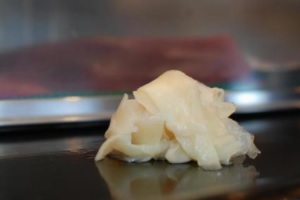
Gari
When you sit a bar, the chef serves "gari" on your table.
Or, when you order a "Nigiri" menu, gari is put at the side of the plate.
Gari is thin-sliced ginger pickled in sweetened vinegar.
It makes your mouth refresh, so eat while waiting for your next sushi.
Hot green tea is certainly served at sushi restaurant.
This also makes your mouth refresh.
Of course, you can drink beer or sake.
And, hot green tea is served at the end of dinner.
You can't find a list of price in most sushi restaurant.
Understand that the sushi are expensive at sushi restaurant.
You can find a price list of lunch menu, but can't find the price list of sushi of each ingredient.
The price of sushi is fixed by the market value of fish and the pay of handwork. So costly ingredient is very expensive.
If you eat your favorite sushi at a bar, the price is probably estimated at 3 to 4 times of the highest price of lunch menu at the restaurant.
Individually one order of ingredient has the price of 300 to 2000 yen.
If you want to eat sushi as much as you can at sushi restaurant, you have to expect that you pay a large fee as expensive as a classy restaurant.
Kaiten-zushi (Conveyor belt sushi, Sushi-go-round)
Kaiten-zushi is a sushi restaurant where the plates with the sushi are placed on a rotating convayor belt and they wind through the restaurant.
You can eat very cheaper sushi than normal sushi restaurant.
Of course, the quality of the ingredients don't come up to ones of normal sushi restaurant.
But it satisfies us successfully.
Because mass production of sushi is needed, most kaiten-zushi restaurants introduce robots shaping sushi.
After you sit in a seat, you pick up the plates with your favorite sushi on the rotating convayor.
And eat them after another as you like.
Probably, you can find the plates with fruits, desserts and other foods are placed.
Of course, you can order any sushi to the chef directly.
Recently, some restaurants introduce touch panel to order.
Gari is in a case on the table.
Eat as you like.
You can find some tea bags, so make yourself a cup of green tea with it on your table.
And you can order beer, miso soup and other special dishes.
The bill is calculated by counting the number and type of plate of the consumed sushi.
Plates with different color, pattern, or shape have different prices.
Usually, the range of price is from 100 yen to 500 yen per a plate.
That is very cheaper than normal sushi restaurant.
In 2023, there were the incidents that a few customers did unsanitary actions to the foods in the restaurant and uploaded the video on youtube.
(They were arrested by the police, and the restaurant demanded damages from them.)
By such incident, the serving system of the plates in some Kaiten-zushi chains is changed to avoid the mischief.
Many chains of kaiten-zushi are in Japan.
The following are the main kaiten-zushi restaurant chains.




